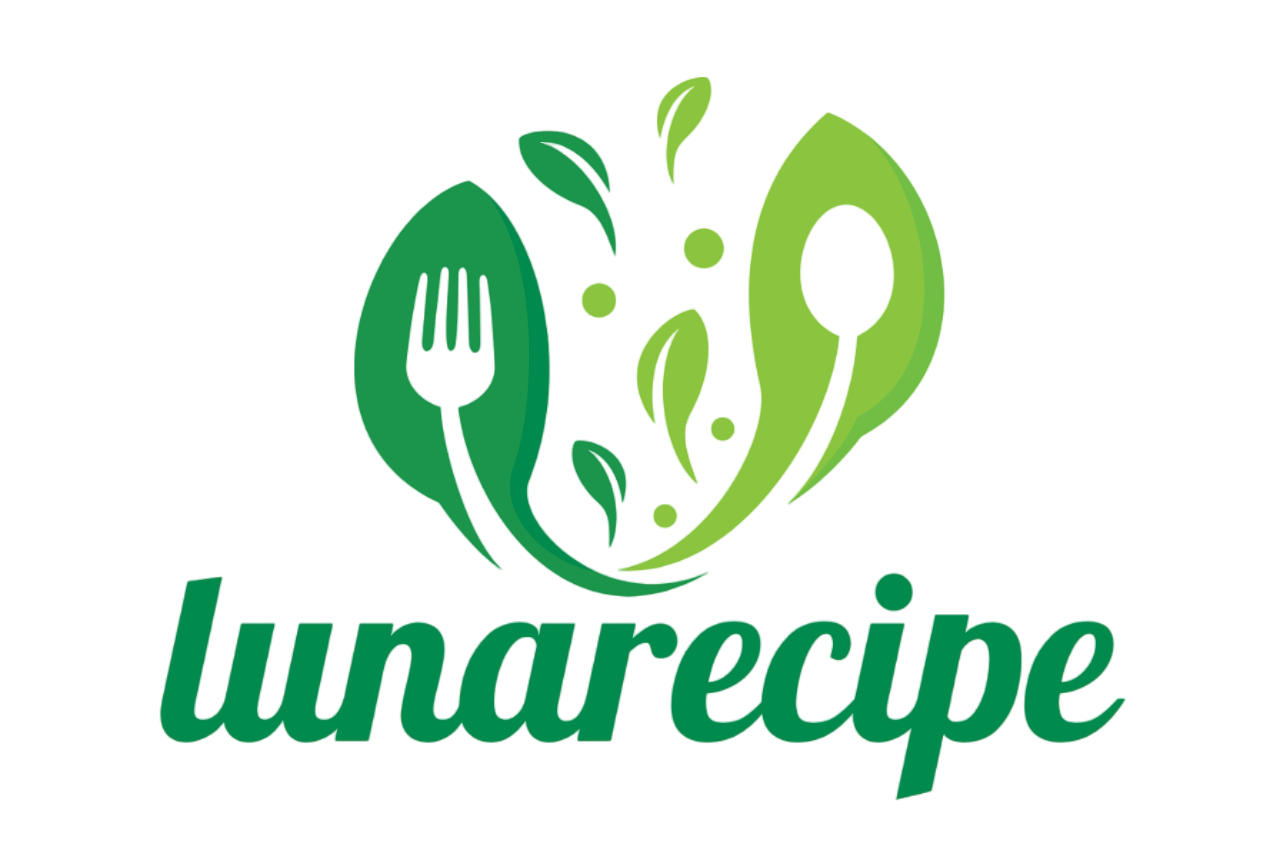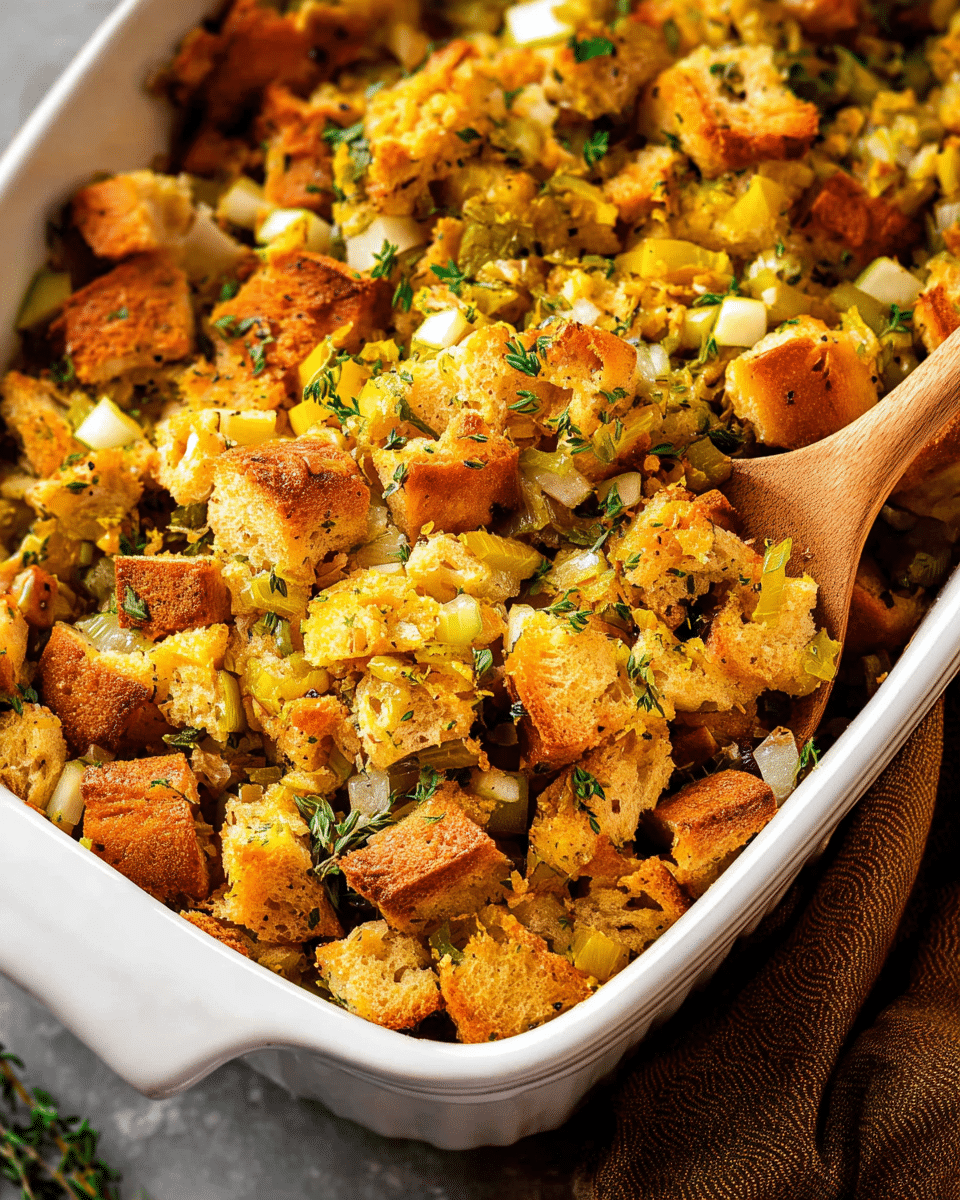This Apple Stuffing brings together the best of both savory and sweet flavors, combining soft cubes of bread with tender apple, fresh herbs, and a light, golden crust. The cranberries add a pop of color and tang, making this dish as beautiful as it is delicious.
Perfect for Thanksgiving, this stuffing will be the highlight of your holiday table. The combination of classic stuffing flavors with the addition of apples gives it a refreshing twist that pairs perfectly with turkey, chicken, or even a vegetarian main course. It’s the ideal side dish to share with family and friends during the festive season.
Full Recipe:
-
6 cups cubed bread (preferably day-old)
-
1 tablespoon olive oil
-
1 onion, chopped
-
2 celery stalks, chopped
-
2 cloves garlic, minced
-
1 apple, cored and chopped
-
1/2 cup dried cranberries
-
1/4 cup fresh parsley, chopped
-
1 teaspoon sage
-
1/2 teaspoon thyme
-
1/4 teaspoon salt
-
1/4 teaspoon pepper
-
2 cups chicken broth (or vegetable broth for a vegetarian version)
-
1/4 cup unsalted butter, melted
Directions:
-
Preheat the oven to 350°F (175°C).
-
Heat olive oil in a large skillet over medium heat. Add the onion and celery, cooking until softened (about 5 minutes).
-
Add the garlic and cook for another 30 seconds until fragrant.
-
Stir in the chopped apple, cranberries, parsley, sage, thyme, salt, and pepper, and cook for an additional 3 minutes.
-
Place the cubed bread in a large mixing bowl. Pour the vegetable and apple mixture over the bread and toss to combine.
-
Gradually add the chicken broth and melted butter, stirring until the bread is moistened but not soggy.
-
Transfer the stuffing to a greased baking dish and cover with aluminum foil.
-
Bake for 25-30 minutes, then remove the foil and bake for an additional 10 minutes to allow the top to become golden brown.
Prep Time: 15 minutes | Cooking Time: 40 minutes | Total Time: 55 minutes
Kcal: 220 kcal | Servings: 6 servings
History and Origin
Stuffing has a long history, dating back centuries, with roots in ancient Rome where it was common to stuff meats with a mixture of breadcrumbs, herbs, and other ingredients. However, the version we know today—often referred to as dressing in some regions—is a product of European influence, particularly from the British and the French.
The introduction of apple stuffing, as we know it now, is a relatively modern innovation, bringing together the beloved tradition of stuffing with the natural sweetness of apples, which are abundant in the fall. Apples have been cultivated for thousands of years, particularly in the northern hemisphere, and have played an important role in culinary traditions worldwide. The pairing of apples with bread-based stuffing became popular as people began incorporating seasonal produce into their holiday dishes, particularly during autumn when apples are at their peak. The addition of apples to stuffing adds a fresh, light balance to the richness of roasted meats, particularly turkey, making it a perfect side for Thanksgiving and other autumnal celebrations.
Variations and Adaptations
While apple stuffing is a beloved dish in many households, there are a variety of ways to prepare it, depending on your preferences or cultural influences.
-
Apple and Sausage Stuffing: For a heartier option, adding sausage to the stuffing creates a rich, savory flavor that complements the sweetness of the apples. You can use pork sausage, turkey sausage, or even vegetarian sausage for a meat-free version. This addition gives the stuffing more depth and turns it into a more substantial dish, suitable as a stand-alone main course for vegetarians.
-
Cranberry Apple Stuffing: The addition of cranberries, as seen in the Apple Stuffing recipe, is a common variation, providing a tangy contrast to the sweetness of the apples. Dried cranberries are particularly popular, but fresh ones can be used for a sharper taste.
-
Gluten-Free Apple Stuffing: For those with dietary restrictions, a gluten-free version can easily be made by using gluten-free bread instead of regular cubed bread. The stuffing will still have all the wonderful textures and flavors, and it’s just as enjoyable for those avoiding gluten.
-
Herb Variations: While sage and thyme are classic herbs used in apple stuffing, feel free to experiment with other herbs like rosemary, oregano, or parsley to give your stuffing a unique twist. Herbs like sage are particularly popular in autumn dishes, adding a warm, earthy flavor that pairs well with the apples.
-
Stuffing with Nuts: Another popular variation includes adding toasted nuts, such as walnuts, pecans, or hazelnuts, which provide a satisfying crunch and an extra layer of flavor. The nuts complement the sweetness of the apples and the earthiness of the herbs, elevating the stuffing’s complexity.
Nutritional Information
Apple stuffing is a relatively balanced side dish, offering a mix of carbs, fiber, healthy fats, and proteins. The exact nutritional breakdown will depend on the specific ingredients you use (like bread type, broth, and butter), but here’s a general overview:
-
Carbohydrates: The primary source of carbs in this dish comes from the bread and apples. Bread provides energy-dense carbs, while apples contribute natural sugars and fiber, which can help support digestive health.
-
Fiber: Apples and the whole-grain bread (if used) contribute a good amount of dietary fiber, which helps regulate digestion and keep you feeling fuller longer.
-
Fats: The butter used in the recipe provides healthy fats, though you can substitute with olive oil for a more heart-healthy alternative. If you add sausage or nuts, the fat content will increase accordingly.
-
Vitamins and Minerals: Apples are rich in vitamin C and potassium, while fresh herbs like parsley and sage are packed with antioxidants, vitamins A and K, and a variety of minerals. Celery also adds a mild but important dose of vitamin K.
-
Calories: One serving of apple stuffing (about 1/6th of the recipe) contains approximately 220 kcal, making it a relatively moderate side dish when compared to other heavier holiday options. The calorie count can vary depending on the ingredients used, especially if you use more butter or add sausage or other fat-rich ingredients.
Serving Suggestions and Pairings
Apple stuffing pairs beautifully with many main dishes, but it’s particularly popular as a side for roast turkey or chicken during the holidays. The rich, savory flavors of the stuffing complement the lean, roasted meats, and the natural sweetness of the apples provides a refreshing contrast.
For a vegetarian meal, apple stuffing can serve as the main dish, especially if you add sausage, nuts, or more vegetables for texture. Consider serving it alongside a hearty vegetable soup or a simple green salad for a well-rounded meal.
Pairing your apple stuffing with a drink can elevate the dining experience even further. For a holiday meal, a glass of dry white wine like Sauvignon Blanc or Chardonnay pairs well with the dish’s savory and sweet profile. Alternatively, a light beer or cider can bring out the apple notes while providing a refreshing contrast to the richness of the stuffing.
Tips and Tricks for Success
-
Use Day-Old Bread: Fresh bread can become too soggy when you add the liquid, so it’s best to use slightly stale, day-old bread for the best texture. You can also dry the bread out in the oven for a few minutes to make sure it soaks up the flavors without turning mushy.
-
Don’t Overstuff: When filling the baking dish, be careful not to overstuff the stuffing. Leave a little room at the top so that the stuffing has space to bake evenly. If it’s packed too tightly, it might not cook through properly.
-
Control the Moisture: If the stuffing seems too dry after baking, add a little more broth or melted butter before serving to reach your desired consistency.
-
Add a Little Sweetness: If you prefer a sweeter stuffing, you can increase the amount of apple or add a drizzle of honey or maple syrup for an extra burst of sweetness.
-
Let It Rest: After baking, allow the stuffing to rest for a few minutes before serving. This helps the flavors meld together and makes it easier to scoop.
Potential Health Benefits
Apple stuffing offers several potential health benefits thanks to its wholesome ingredients. Apples are packed with dietary fiber, antioxidants, and vitamin C, supporting digestive health, immune function, and skin health. The addition of fresh herbs, particularly sage and thyme, can help with digestion and may even have anti-inflammatory effects.
Advertisement
The use of whole-grain or gluten-free bread can add extra fiber and nutrients, contributing to heart health and better blood sugar control. The nuts, if added, are rich in healthy fats that support brain health and provide a satisfying crunch.
Conclusion
Apple stuffing is a versatile and crowd-pleasing dish that brings together the best of autumn flavors in every bite. Whether you’re preparing it for a holiday feast or as a comforting side for a family dinner, it’s a dish that offers a delicious balance of savory, sweet, and herby notes. With endless variations and the option to customize it to suit different dietary preferences, apple stuffing is sure to become a beloved recipe in your kitchen. So go ahead, give it a try, and watch it become a staple in your holiday or weeknight meals.





